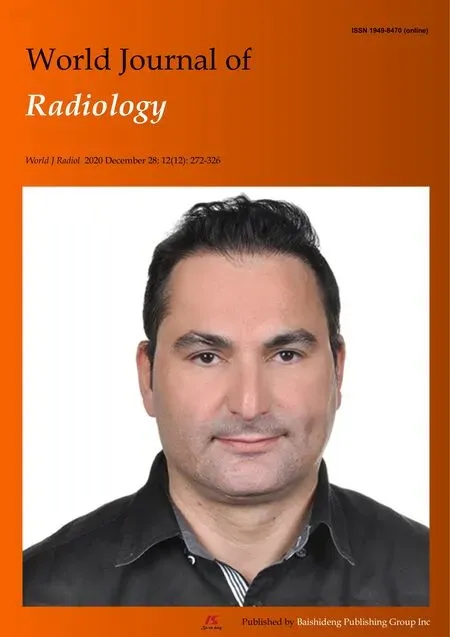Feasibility of using ultrasound in ambulances in Saudi Arabia
2021-01-13AbbasShakhreetBZAlghamdiWaliAlelyaniAlshehri
Abbas I, Shakhreet BZ, Alghamdi A, Wali B, Alelyani B, Alshehri T
Abstract BACKGROUND In developed countries, the economic feasibility of using ultrasound in ambulances before arriving at the hospital has been achieved through comprehensive studies, and this of course does not apply to Arab countries, as there are no current studies to support this. Therefore, this study is a preliminary measure of the economic feasibility of using ultrasound in ambulances in Saudi Arabia.AIM To measure the demand for ultrasound equipment in ambulances in Saudi Arabia.METHODS A cross-sectional study of five different groups of participants including radiation technologists, emergency physicians, paramedics, Red Crescent managers and the public. Email and social media were used to deliver a questionnaire to these groups. The questionnaire included specific questions to measure the purpose of ultrasound use in each group of participants.RESULTS Each group had some knowledge on ultrasound and its benefits. More than 50%in each study group supported the availability of ultrasound in ambulances.Additionally, 60% of emergency physicians reported that they had difficulties in venous access, checking the presence of internal bleeding, recognizing pregnancy in trauma cases, and inserting endotracheal tubes, and the majority of them confirmed the effective role of ultrasound in achieving such tasks. Almost all paramedics (93.33%), physicians (98.89%), and Saudi Red Crescent managers(96.3%) emphasized the importance of communication between ambulance staff and emergency departments. Moreover, most physicians (77.78%), and technologists (82.73%) supported the presence of paramedics in ambulances to operate ultrasound in order to improve patient outcomes.CONCLUSION Most of the study groups evaluated had knowledge on ultrasound and supported the presence of ultrasound devices in ambulances.
Key Words: Feasibility; Ambulance; Prehospital ultrasound; Health economy; Medical imaging; Emergency
INTRODUCTION
Ultrasound is a radiographic modality featuring non-ionizing radiation equipment.Previously, it was mainly available in hospitals for extensive investigations of obstetric, vascular, and abdominal diseases.
The localized utility of this specialized equipment was due to its massive size that complicated its delivery from one site to another.
During the 90s, it was transformed to a small portable lightweight ultrasound machine with high-resolution images by several medical imaging companies.
This modern radiographic modality has progressively extended its practical use outside hospitals and is known as "prehospital ultrasound".
Qualified technicians and emergency practitioner utilize this technology in critical cases, such as pleural, peritoneal, and ectopic pregnancy rupture. This is successfully carried out in private ambulances typically in several developed nations,such as the United States, Germany, France, and Italy.
Practical experience has demonstrated the significant role of this modality in private ambulances. It has been extensively reported that unanimously adopting this mobile technology enables accurate interpretation of unclear questions at the scene, which would accelerate the continuous process of accurate diagnosis and better patient outcomes in appropriate time sensitive emergency conditions.
Although there are a modest number of comprehensive studies which have investigated the economic feasibility of using prehospital ultrasound in private ambulances in developed countries, there are no studies in Arab nations to adequately support the use of ultrasound in ambulances. Therefore, this is a preliminary study on the economic feasibility of ultrasound in private ambulances in Saudi Arabia.
The primary aim of this study is to measure the economic demand in Saudi ambulances for ultrasound equipment. Other aims include: (1) to determine the background regarding ultrasound equipment in Saudi society; (2) to identify the extent of support in paramedics for deploying ultrasound equipment in Saudi ambulances; (3) to investigate the economic feasibility of leading providers(paramedics) to learn how to correctly operate ultrasound equipment in private ambulances; (4) to realize the potential utility of prehospital ultrasound in traumatic and non-traumatic cases; and (5) to determine its role as a direct communication tool between the private ambulances and local emergency departments.
MATERIALS AND METHODS
This extensive study was conducted to assess the economic feasibility of gradually introducing ultrasound devices into private ambulances in the Kingdom of Saudi Arabia. The participants were distributed over three specific sections to include local hospitals, the Red Crescent and the local public. The first and second sections,respectively, included skilled radiation technologists, emergency physicians,paramedics and Red Crescent managers, and the third section included the local public.
Five questionnaires were carefully designed to obtain reliable data in this study.Each organized questionnaire included two specific sections. Section I included questions related to demographic details and local background with special regard to the participants. Section II included specific questions that accurately measured specific economic factors in each completed survey. The sections included a unique blend of qualitative and quantitative data.
All structured questionnaires were directed at a specific group of active participants. The process of distributing the extensive survey started on November 18,2017 and ended on February 27, 2018. Before completing the developed questionnaires, the five groups of participants were carefully selected from targeted participants to scientifically verify their validity.
These questionnaires were typically sent to the target groupse-mail and social media. We planned to set a 4-wk waiting time to receive direct responses from all active participants before starting qualitative data analysis. The data from these participants were promptly entered into a Social Sciences Statistical Package to efficiently generate social graphs and determine statistically significant relationships.
RESULTS
Demographic information
This comprehensive study included 1365 participants (105 paramedics, 1000 members of the public, 90 emergency medical practitioners, 60 Saudi Red Crescent managers and 110 technologists) with a diverse knowledge background as shown in Figure 1.
The local public represented a significant proportion (73.2%) of the identified participants. The majority were females (64.4%). A substantial proportion (56.9%) of younger participants (20-40 years old) were included. Elderly participants represented approximately 33%, while local adults represented around 10%. The response rate was highest (60%) in Jeddah City compared to other Saudi cities. About 80% of participants had a university degree, while 17% of them had a secondary qualification. Only 2.7%had intermediate level qualifications as shown in Table 1.
Paramedics represented another group and accounted for 7.6% of the included participants. The majority of paramedics were male (90.5%) and young (90.5%). The response rate was 74.3% outside Jeddah compared to Jeddah City. Most of these participants had undergraduate degrees and diplomas (49.5% and 41%, respectively).Those with postgraduate qualifications accounted for the smallest proportion (9.7%),as shown in Table 2.
Emergency medical practitioners also participated in the study. They represented 6.6% of the study participants. Male medical practitioners represented 78.9%, while the more recent age of them represented 81.1%. Most of the respondents (70%) resided outside Jeddah. Most active participants were educated and held an undergraduate degree (63.4%), master’s degree (24.4%) or PhD (12.2%). Half of these participants had less than 5 years of experience, while 27.8% of them had more than 10 years of experience. Almost one quarter had between 5 and 10 years of experience (Table 3).
Saudi Red Crescent managers represented the smallest proportion of this study group (4.3%), and most of them were young (90%) and from outside Jeddah (Table 4).
Creative technologists were also included in the study, and represented 8% of all participants. Male technologists accounted for 40.9%, while female technologists accounted for 59.1%. The majority of creative technologists were young (94.5%). The participants' response rate was approximately similar in and outside Jeddah at 48.2%and 51.87%, respectively. Approximately 90.9% of participants had a diploma and 6.4% of them graduated with a bachelor’s degree, while only 2.7% graduated with a postgraduate degree. Most creative technologists (78.2%) had less than 5 years of experience, 13.6% of them had between 5 and 10 years of experience, and 8.2% had more than 10 years of experience (Table 5).
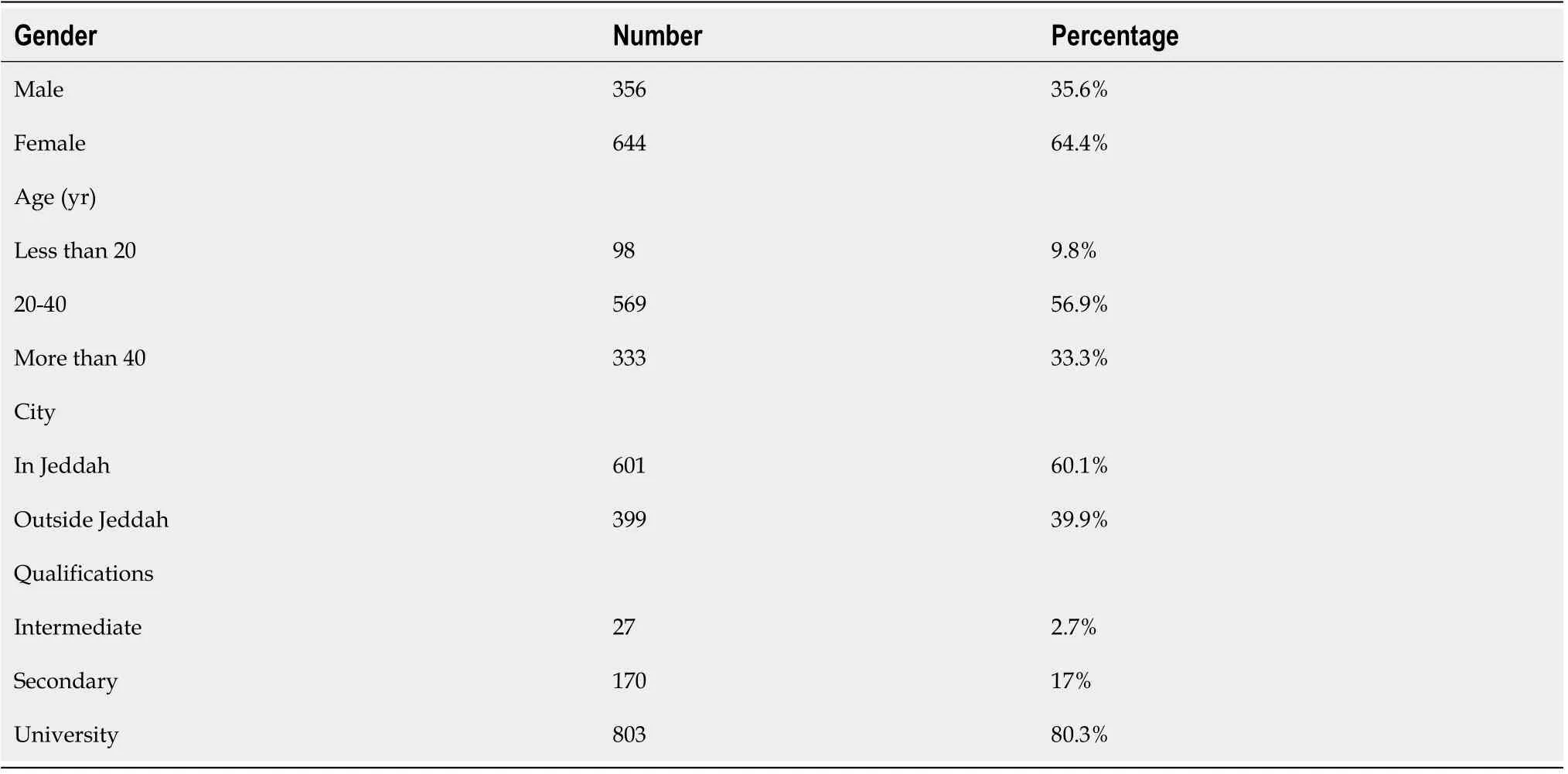
Table 1 Demographic data on the general public

Table 2 Demographic data on paramedics
DISCUSSION
Paramedics, Saudi Red Crescent managers, and public knowledge of ultrasound
A favorable opinion on embracing ambulances in Saudi was established in 1935 to provide sufficient medical services for the local society. The key role in this ambitious project was limited to delivering urgent cases to recipient emergency departments.
Currently, its leading role has been extended to provide an accurate diagnosis and obtaining better outcomes for patient care at the local scene. This evolvement was driven by the possible presence of ultrasound in private ambulances. Severaldeveloped countries have proved the efficacy of this modality. Local knowledge on this modality in the Saudi population was investigated in this study. When the general public was asked about their knowledge on ultrasound, it was observed that almost 80% of them had background knowledge regarding ultrasound (Figure 2).
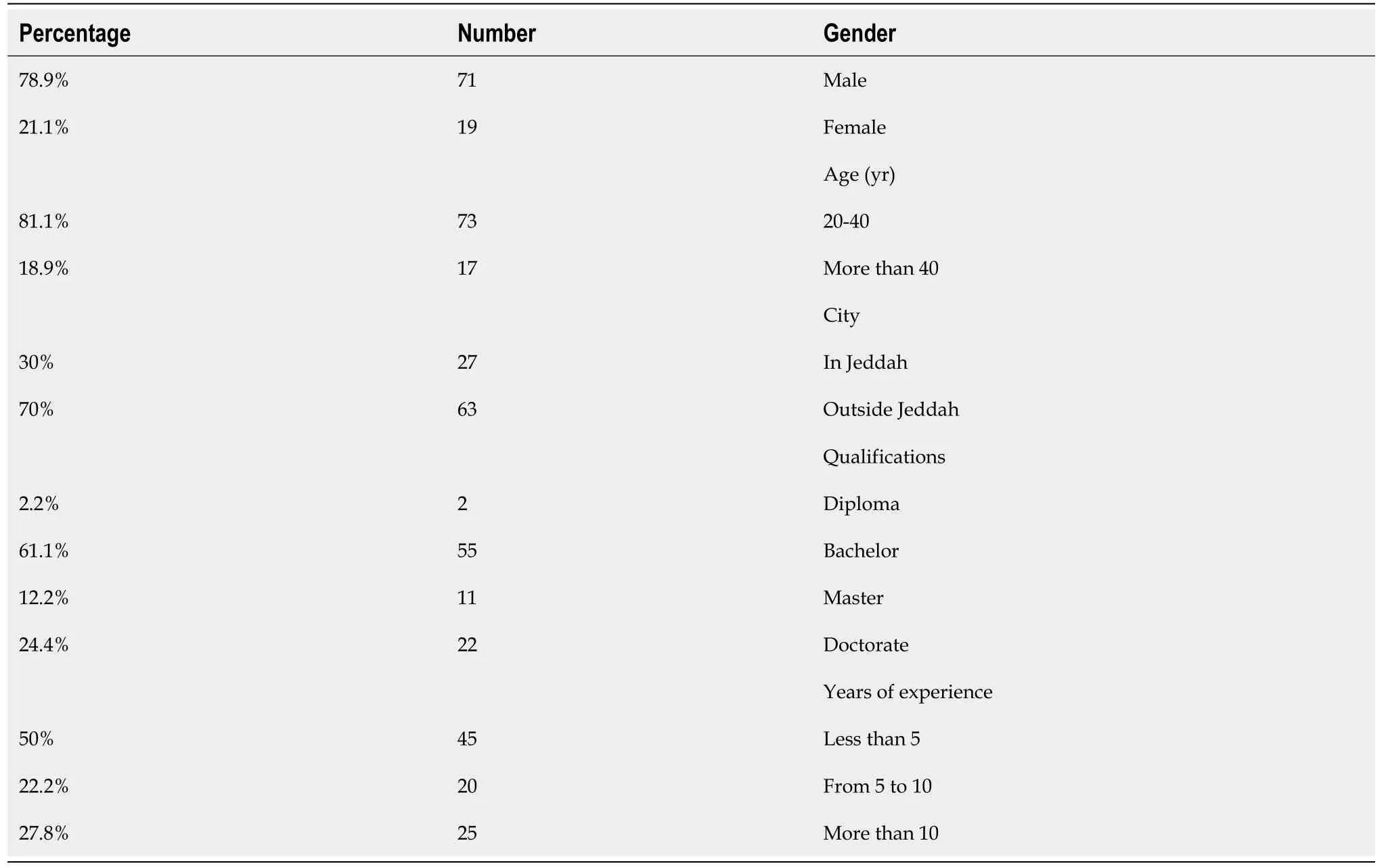
Table 3 Demographic data on emergency medical physicians

Table 4 Demographic data on Saudi Red Crescent managers
This indicated that most of the general public were aware of the economic benefits of this modality in the medical field due to their local knowledge. A direct correlation between the qualifications achieved by the public and local knowledge of ultrasound was observed in this study. It was evident that individuals who had qualifications were knowledgeable regarding this modality (= 12.787,value, 0.01) as shown in Table 6.
Moreover, paramedics were also asked about their knowledge of ultrasound in this study. It was observed that 70% of them typically had extensive background knowledge on this modality (Figure 2). A direct relationship between the qualification level of paramedics and extensive knowledge on ultrasound was determined. It was noted that high-level qualified paramedics had more knowledge on this modality (=12.486,value, 0.05) as shown in Table 7.
This correlation was consistent with published findings by Unlüerwho reported a significant relationship between the qualification level of paramedics and their direct knowledge on ultrasound. Additionally, this question was directed to Saudi Red Crescent managers and 80% of them reported that they had extensive background knowledge on ultrasound (Figure 2).
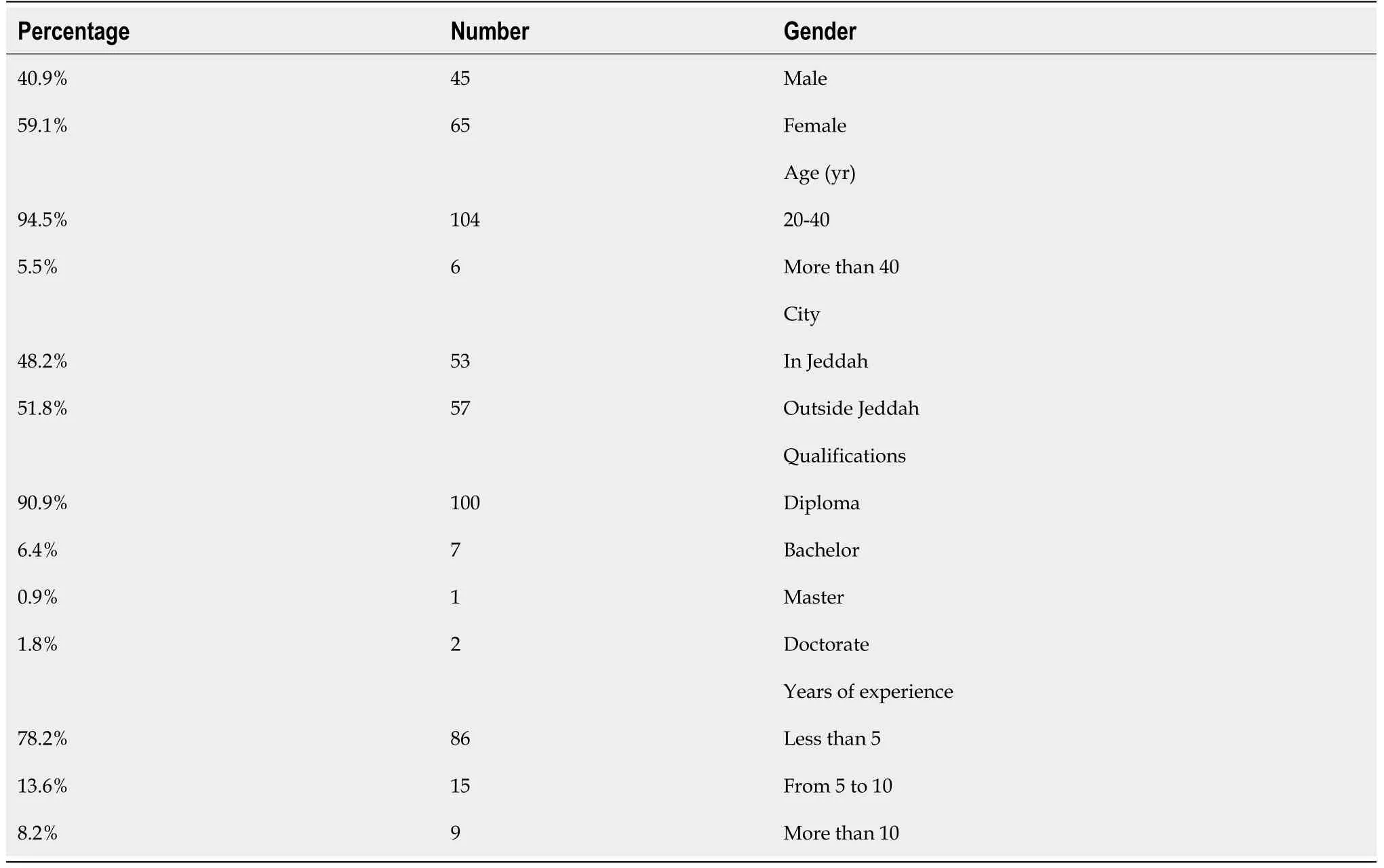
Table 5 Demographic data on technologists

Table 6 Relationship between participant qualification and their knowledge on ultrasound

Table 7 Relationship between paramedic qualification and their knowledge on ultrasound
The extent of society support for the presence of ultrasound in ambulances
Public (85.8%) support for the presence of ultrasound devices in private ambulances is shown in Figure 3. A significant correlation was observed between selected local participants’ knowledge on ultrasound and the extent of public support for the continuous availability of ultrasound in private ambulances.
It was observed that individuals who were knowledgeable regarding ultrasound thoroughly recommended the possible presence of this modality in private ambulances (= 73.268,value, 0.000) as shown in Table 8.
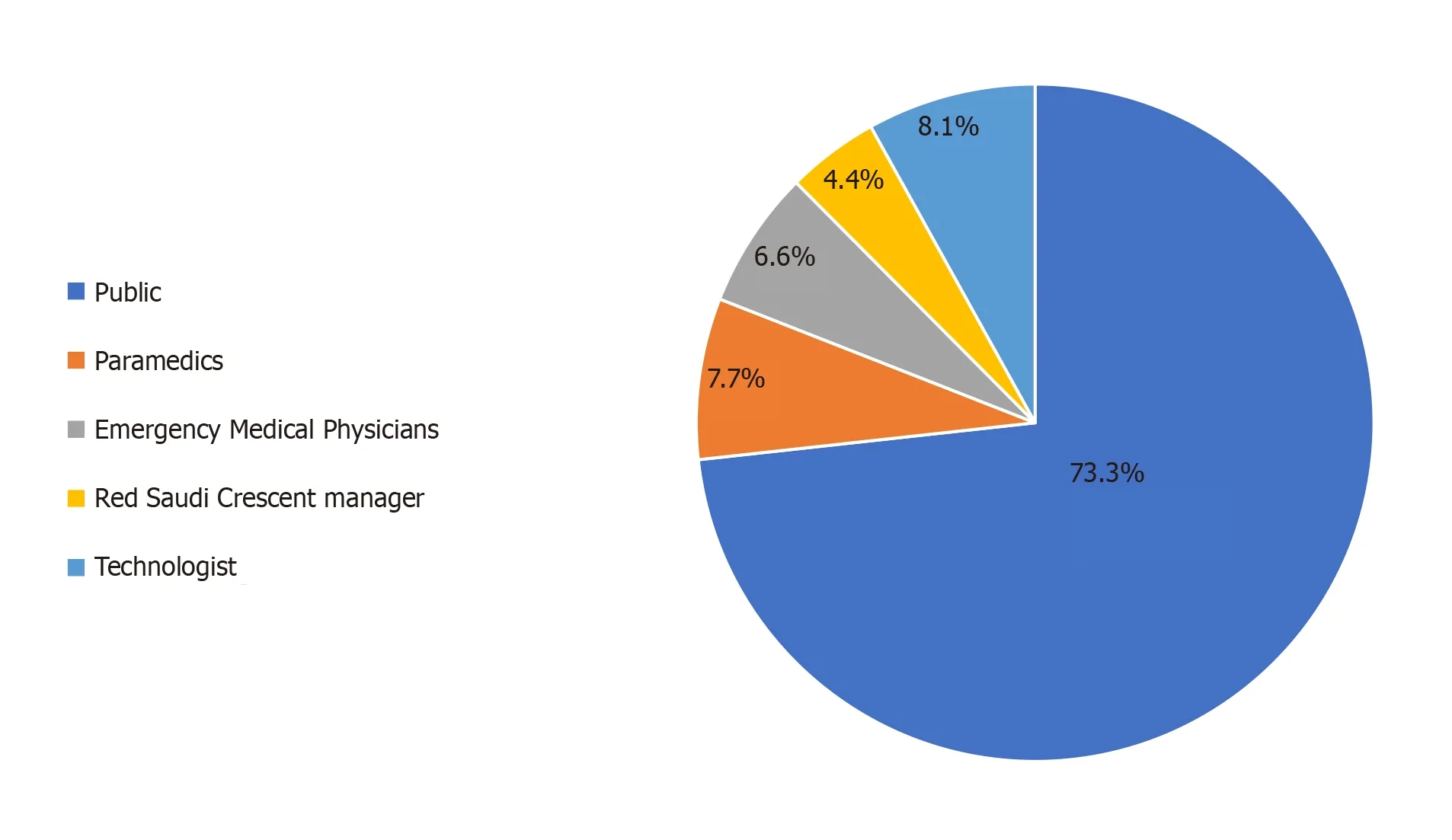
Figure 1 Distribution of study sample.
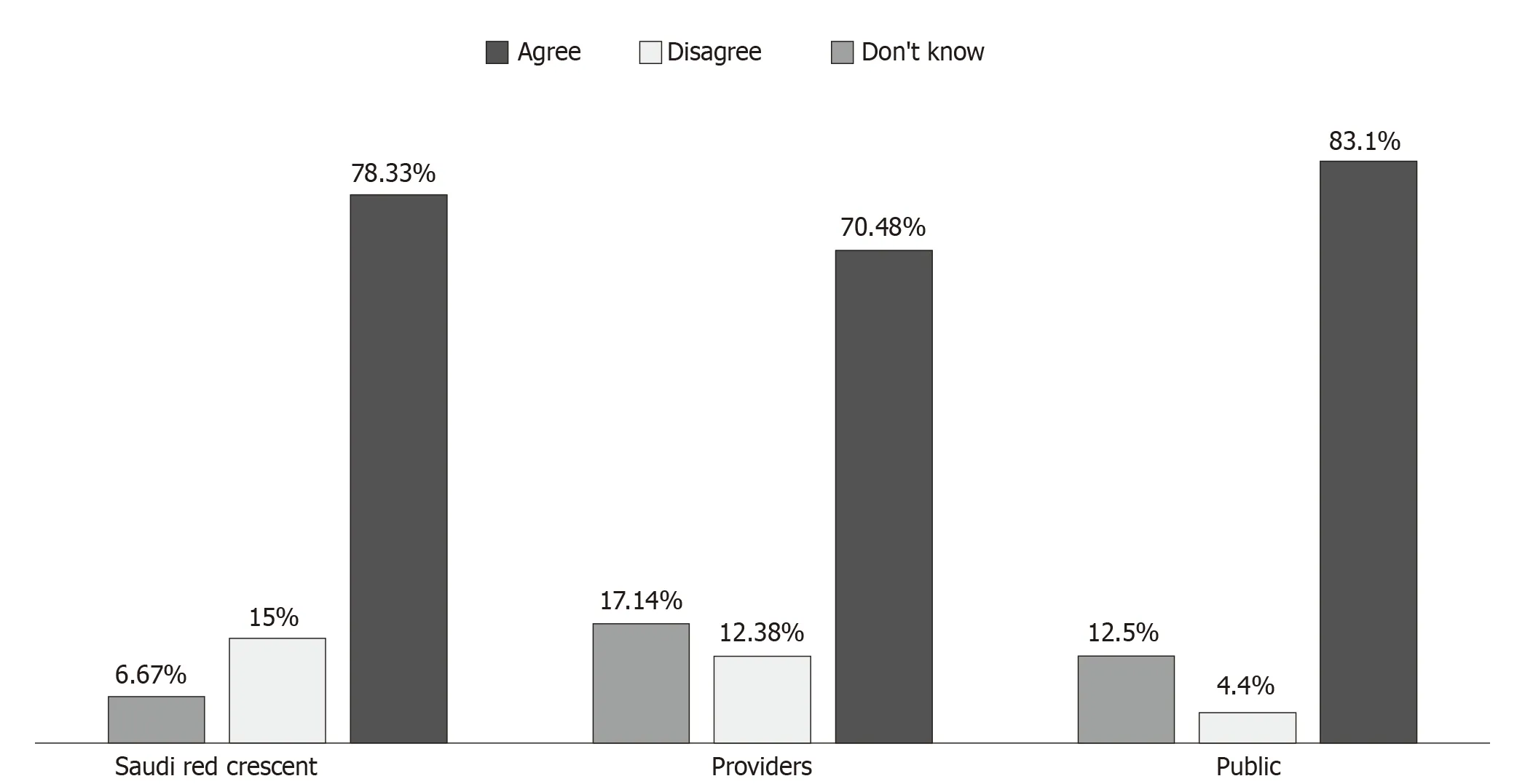
Figure 2 Knowledge on ultrasound.
In addition, approximately 60% of emergency physicians suggested that the possible presence of ultrasound in private ambulances was valuable, while 20% were against this idea (Figure 3).
The local availability of this mobile technology was also recommended. They reported that ultrasound could assist physicians in the correct diagnosis and appropriate intervention in critical medical situations.
The association between the practicing physician’s qualification level and the desire for implementation of ultrasound in private ambulances was determined. The results showed that physicians who usually have higher education levels supported the usefulness of ultrasound in private ambulances (= 11.755,value, 0.01) as shown in Table 8. This finding confirmed a significant association between physician’s qualification level and the desire to implement ultrasound in private ambulances.
Furthermore, more than half of Saudi Red Crescent managers recommended the presence of ultrasound in private ambulances, while 20% of them steadfastly refused this idea (Figure 3). The direct correlation between the practical knowledge ofresponsible managers on ultrasound and their active support for its implementation in private ambulances was significant. It was observed that managers who typically had extensive background knowledge on ultrasound supported the local availability of this device in private ambulances (= 24.156,value, 0.000) as shown in Table 8.
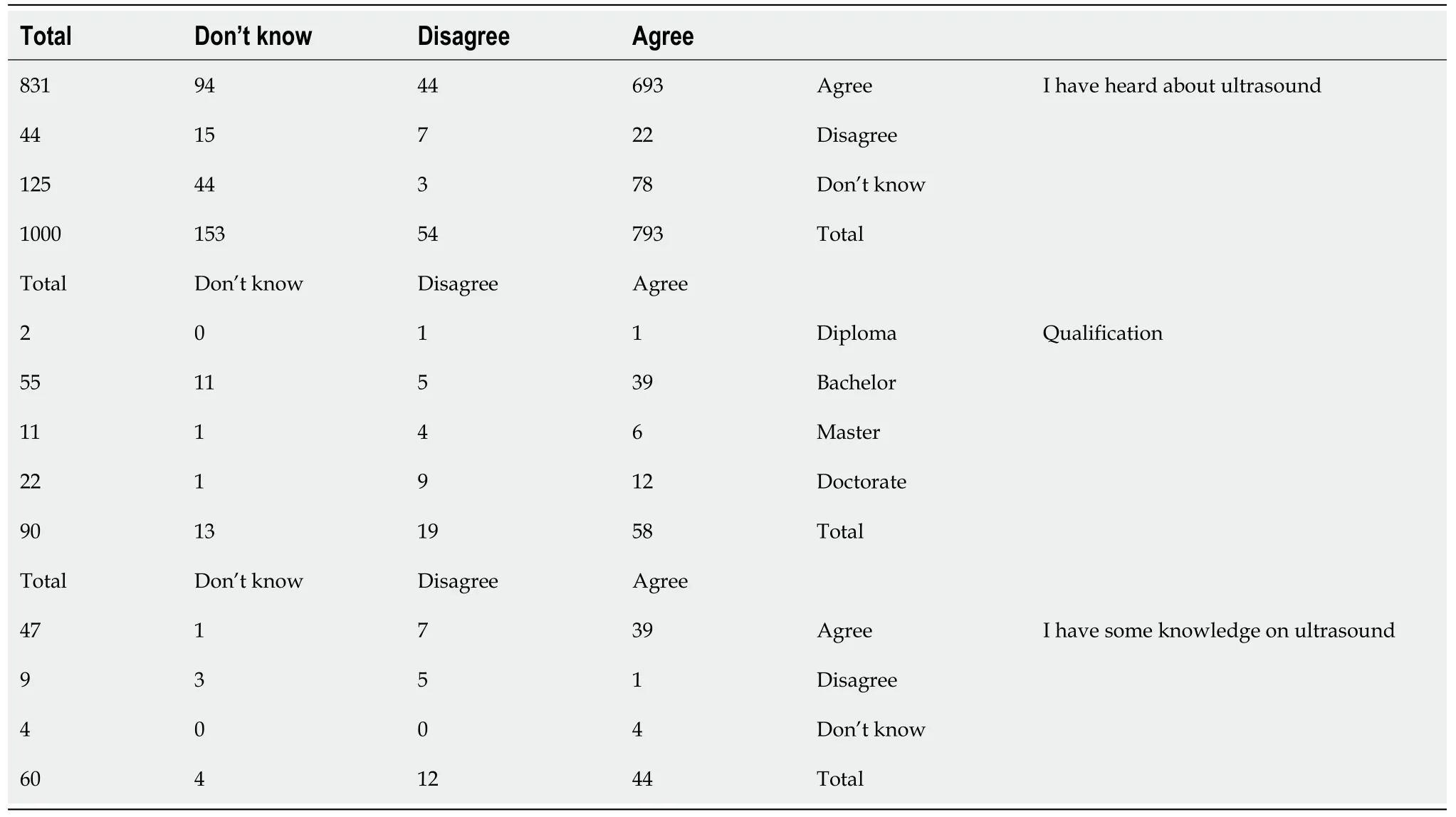
Table 8 Relationship between participants knowledge on ultrasound and the introduction of this device in ambulances due to its ability to diagnosis many pathologies
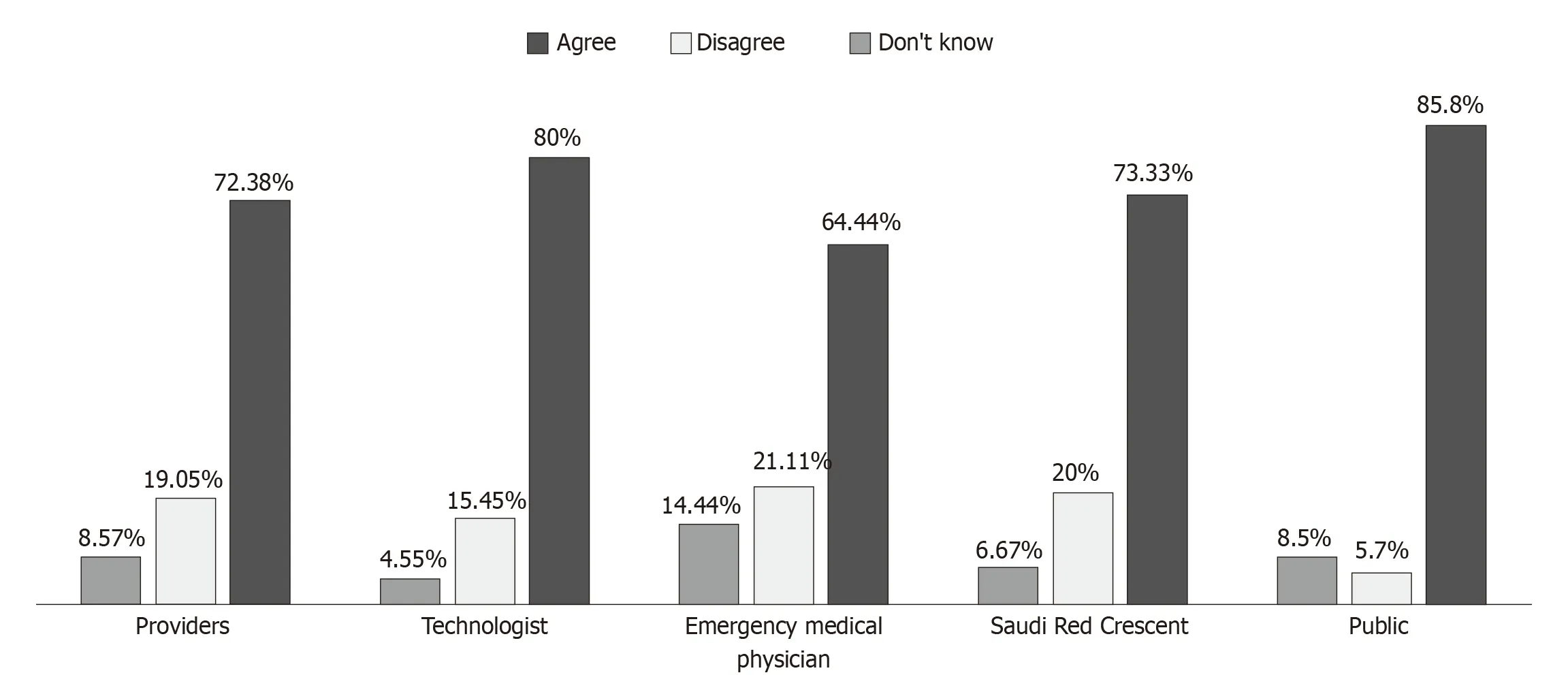
Figure 3 Opinion on the inclusion of an ultrasound device in an ambulance.
Most creative technologists (80%) agreed with the presence of ultrasound in private ambulances and only 20% disagreed (Figure 3). A significant correlation between the education level of creative technologists and their extent of support for ultrasound in private ambulances was observed. It was evident that creative technologists with a higher education level strongly recommended this innovative idea (= 48.412,value, 0.000) as shown in Table 9.
Additionally, 72.38% of paramedics recommended the presence of ultrasound devices in ambulance, while 19.05% were against this innovative idea (Figure 3).

Table 9 Relationship between the education level of creative technologists and the extent of their support for the introduction of ultrasound devices in ambulances
The feasibility of paramedics using an ultrasound machine in an ambulance
In response to the feasibility of paramedics using an ultrasound machine in an ambulance, 83.8% of paramedics agreed with the importance of conducting training programs on ultrasound and its use in an ambulance (Figure 4A).
This finding was universally supported by several published studies which showed that trained paramedics could precisely detect pathology and should be trained by qualified physicians. However, Brownrevealed that such training programs required more time to achieve. As a result, a qualified trainer should carefully consider the economic challenges in correctly performing such innovative programs.More than half of paramedics enrolled in this study were not accompanied by sonographers to operate the ultrasound device in an ambulance, while others (34.2%)recommended their possible presence (Figure 4B).
Technologists in this study were asked to comment on providing ultrasound courses for paramedics to operate the device in an ambulance. Most of them (82.73%)agreed with this approach and only 9.09% of them disagreed (Figure 5A).
The opinions of emergency medical physicians on these courses for paramedics were also determined. It was observed that most physicians (64.44%) agreed with the programs for paramedics, while 21.11% disagreed (Figure 5B).
In addition, almost 55% reported their reliance and confidence on the reports of qualified paramedics created at the scene, which indicated their readiness for this approach (Figure 5C).
The usefulness of this modality for critical cases
Emergency medical physicians were asked about the practical challenges they face while evaluating critical cases such as, finding venous access, detection of internal bleeding, recognizing pregnant status in trauma cases and insertion of an endotracheal tube or thoracotomy tube. More than 60% of them reported they encountered difficulties in achieving these emergency tasks, while 20% stated they did not encounter any difficulty when they performed these procedures (Figures 6-8).Furthermore, 40% of practicing physicians mentioned that the presence of an ultrasound device in private ambulances would be helpful for inserting an endotracheal tube, 30% disagreed with this statement, while the remaining 30% did not respond to this statement (Figure 6).
A published study by Werner and colleagues, reported that prehospital ultrasound improved the accuracy of tube placement in the trachea. Additionally, the majority of practicing physicians (90%) recommended using an ultrasound device in private ambulances, as it could promote accurate venous access (Figure 7).
Several published studies have demonstrated the leading role of ultrasound in venous access compared with the conventional approach (palpation). Almost 70%of practicing physicians supported this approach, due to the ability to clearly detect internal bleeding before complications occurred (Figure 8).
This finding confirmed the results of El Sayedregarding the accuracy of ultrasound in detecting bleeding. Moreover, physicians added that ultrasound would be useful in their extensive evaluation of unconscious injured women in terms of pregnancy. More than 70% of physicians reported that they experience challenges in diagnosing these cases, due to difficulty in discriminating between pregnant women and women with abdominal distension. Others (10%) stated that such cases could be diagnosed easily with experience (Figure 9).
In addition, 60% of practicing physicians recommended the availability of ultrasound in ambulances, due to the ability to decide on the type of pregnancy in relation to transferring women with severe abdominal pain (Figure 9).

Figure 4 Diagram of the importance of providing ultrasound courses for paramedics and the presence of a sonographer in the ambulance. A: The importance of providing ultrasound courses for paramedics; B: The importance of the presence of a sonographer in the ambulance.
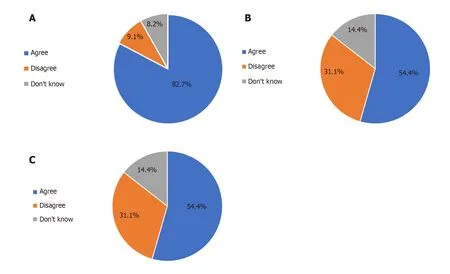
Figure 5 Diagram of sonographers and physicians opinions. A: Sonographers opinions on paramedic ultrasound training; B: Physicians opinions on the presence of ultrasound devices in ambulances; and C: The dependence of emergency physicians on the report by trained paramedics or sonographers.
A significant correlation between the presence of ultrasound in an ambulance and improving patient outcomes was observed in this study.
The majority of practicing physicians who supported the presence of ultrasound in ambulances reported that they could create a treatment plan before critical cases reach the emergency department, which in turn will improve patient outcomes (= 34.256,value, 0.00) as shown in Table 10.
On the other hand, the majority of paramedics (90%), physicians (100%), and Saudi Red Crescent managers (95%) emphasized the importance of communication between the ambulance and the emergency department (Figure 10).
CONCLUSION
This preliminary study investigated the economic importance of progressivelyintroducing ultrasound machines in Saudi Arabian private ambulances. It is noteworthy that the majority of the study groups had some knowledge of ultrasound and supported the presence of ultrasound devices in private ambulances. In particular,paramedics can undoubtedly use this modality in ambulances without any obstacles.Direct communication between the private ambulances and local emergency departments was recommended by all participants in this study due to its beneficial impact on patient outcomes.

Table 10 Relationship between the benefit of applying ultrasound and the feasibility of prehospital ultrasound to create a treatment plan before reaching the emergency department
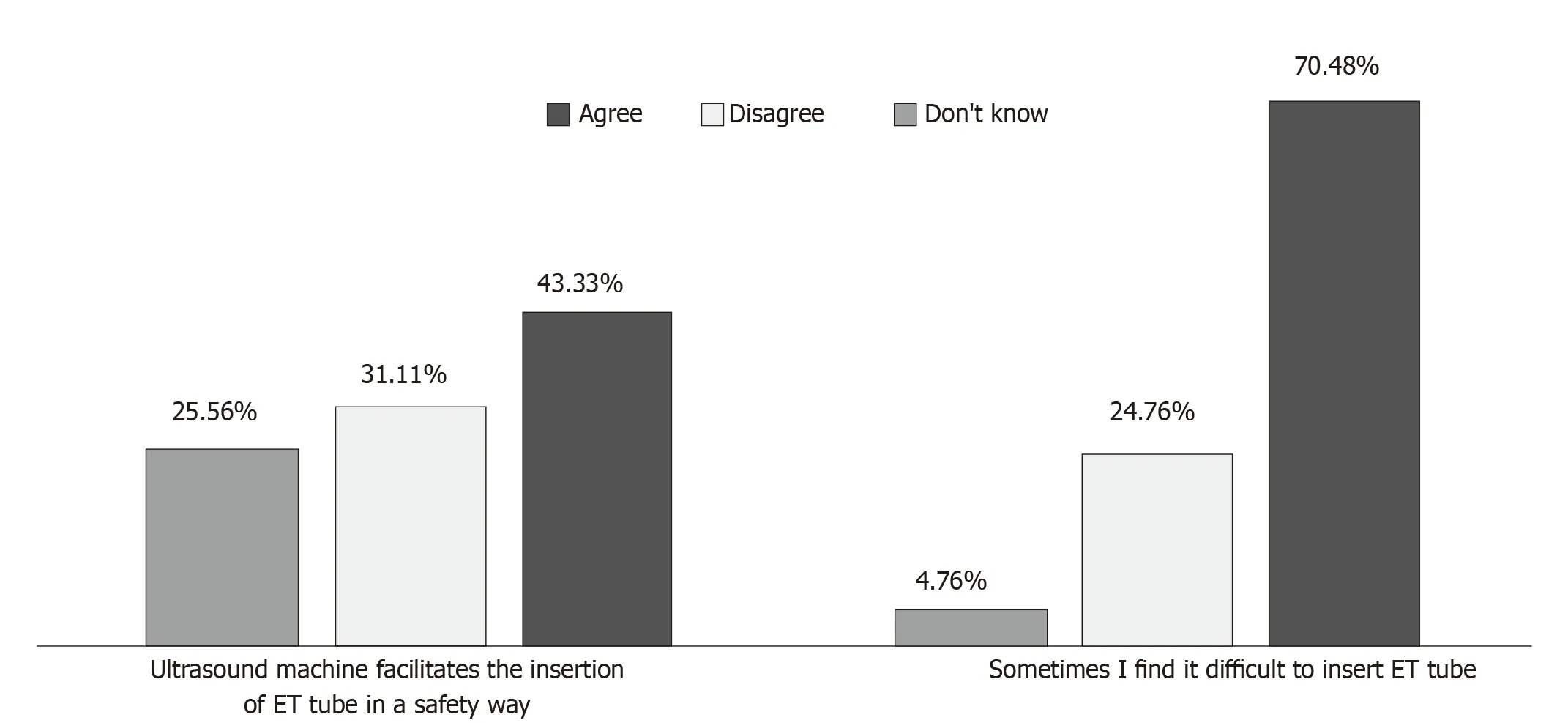
Figure 6 Endotracheal tube insertion.
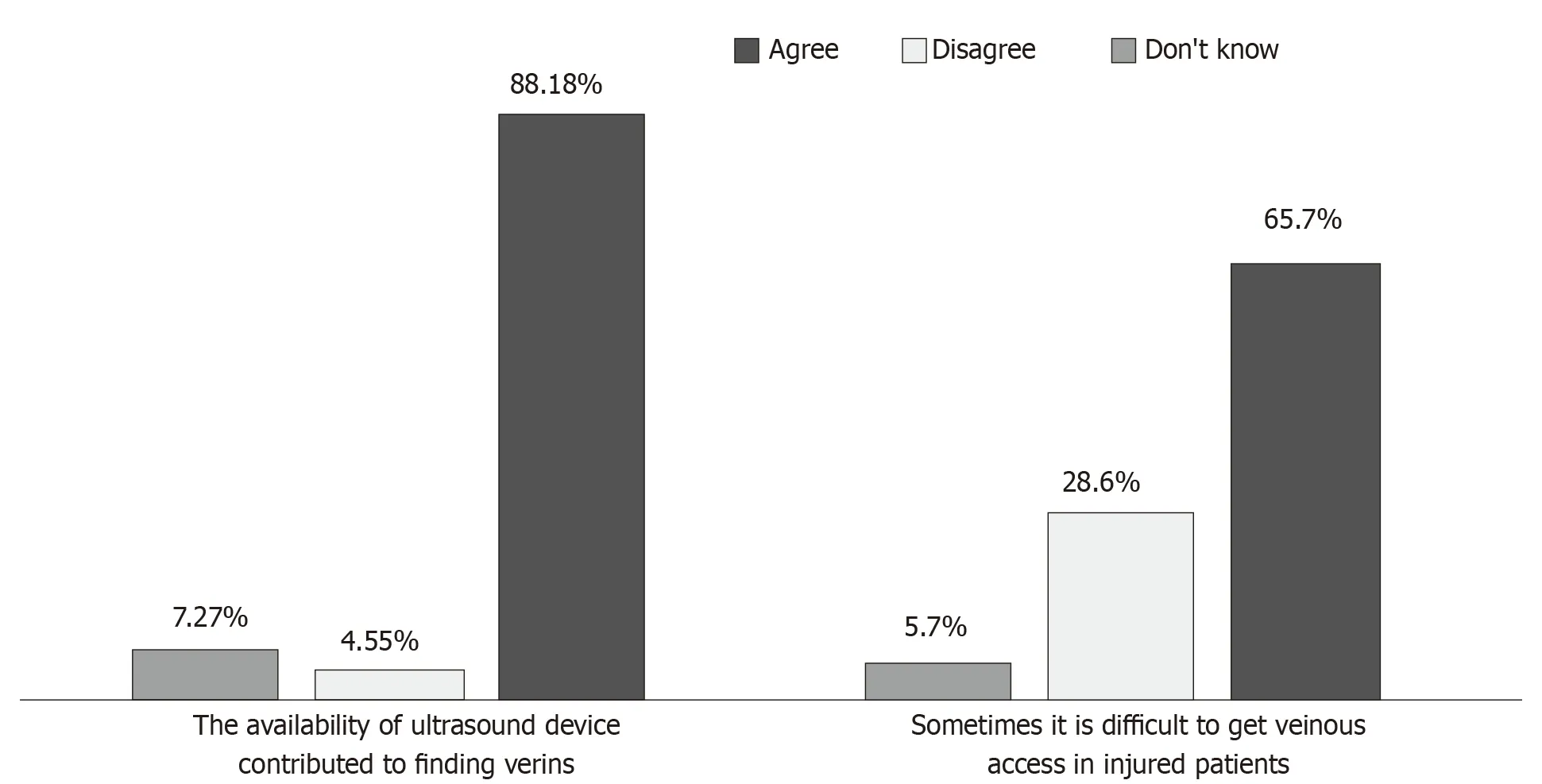
Figure 7 Venous access.
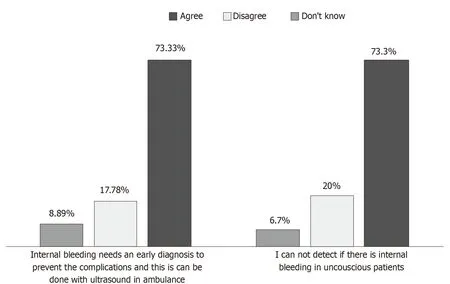
Figure 8 Internal bleeding.
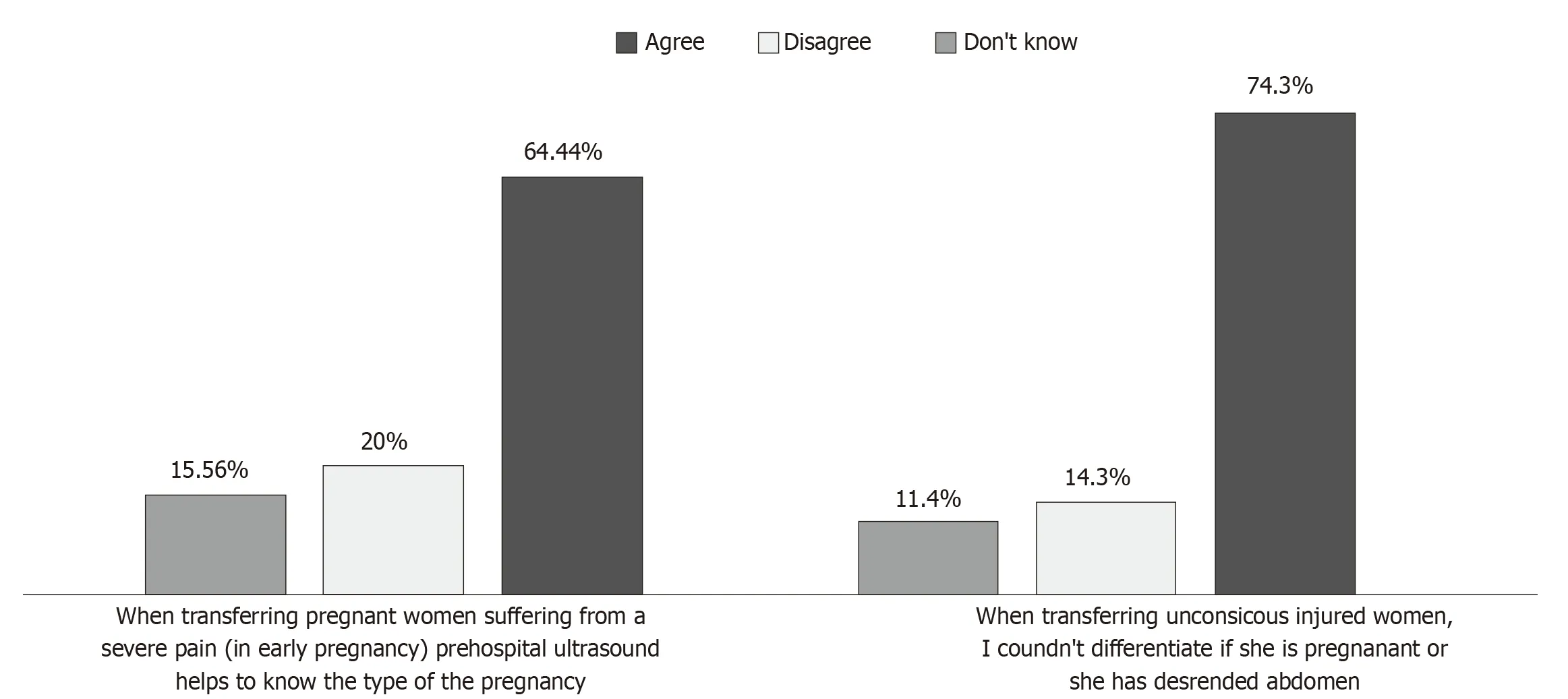
Figure 9 Pregnancy status.
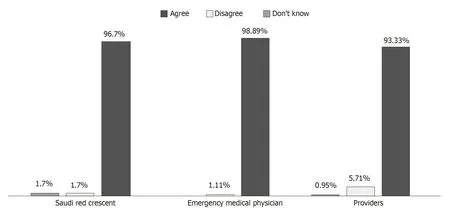
Figure 10 Communication between ambulances and emergency departments.
ARTICLE HIGHLIGHTS
Research background
Ultrasound is a non-invasive modality, and is an established diagnostic procedure in hospitals, but is not yet widely used in prehospital emergency medicine. Therefore,more studies are needed on fast diagnosis using prehospital ultrasound in emergencies.
Research motivation
The use of ultrasound in ambulances occurs in many countries such as the United States and Europe. It has been proved to be successful for early diagnosis in emergency cases before the patient arrives at the local hospital. This encouraged us to conduct this prospective study in the Kingdom of Saudi Arabia to determine the economic feasibility and benefit of ultrasound devices in ambulances.
Research objectives
To determine if prehospital ultrasound could contribute to reduced mortality due to early diagnosis.
Research methods
This research is considered an applied study. The selected sample included participants who provided informed consent. Information was obtained from experienced staff from the radiology department, local emergency department and ambulance center. Survey questionnaires were designed to gather reliable data.
Research results
The results from both male and female participants in different age groups indicated that they supported the introduction of ultrasound devices in ambulances.Participation rates were as follows: paramedics 65%, emergency physicians 60%, Saudi Red Crescent managers 73.3%, sonographers 80% and the general public 81%.
Research conclusions
Adequate use of ultrasound in ambulances for critical patients may perform a key role in improving patient outcomes.
Research perspectives
The analyses and conclusions of participant responses in this study were identical to what we expected. Thus, the implementation of ultrasound devices in ambulances in the Kingdom of Saudi Arabia is feasible.
ACKNOWLEDGEMENTS
Most importantly, we gratefully thank our research supervisor Dr. Ibrahim Abass and co-supervisor Dr. Bassam Shakhreet for their valuable support and dedicated involvement. We would also like to thank Mr. Ibrahim Kanbayti for his continuous support, incredible patience and practical motivation, in addition to his continued guidance and considerable input in writing this extensive project at every step.
